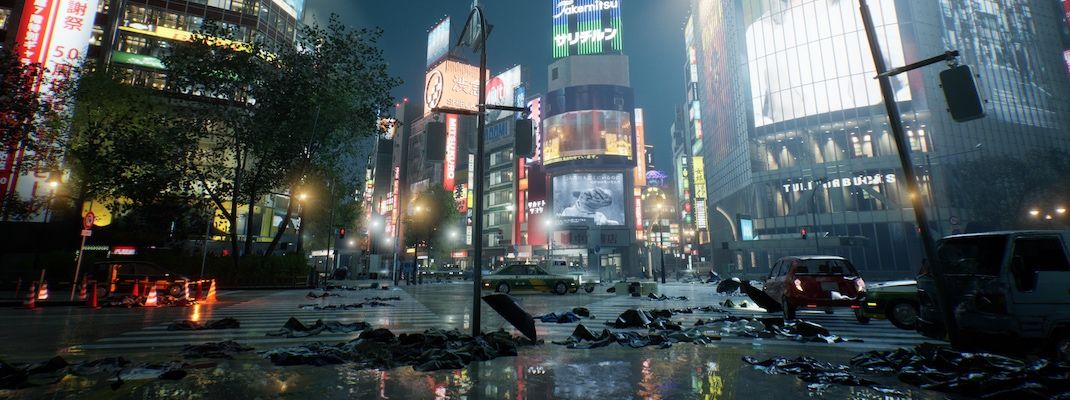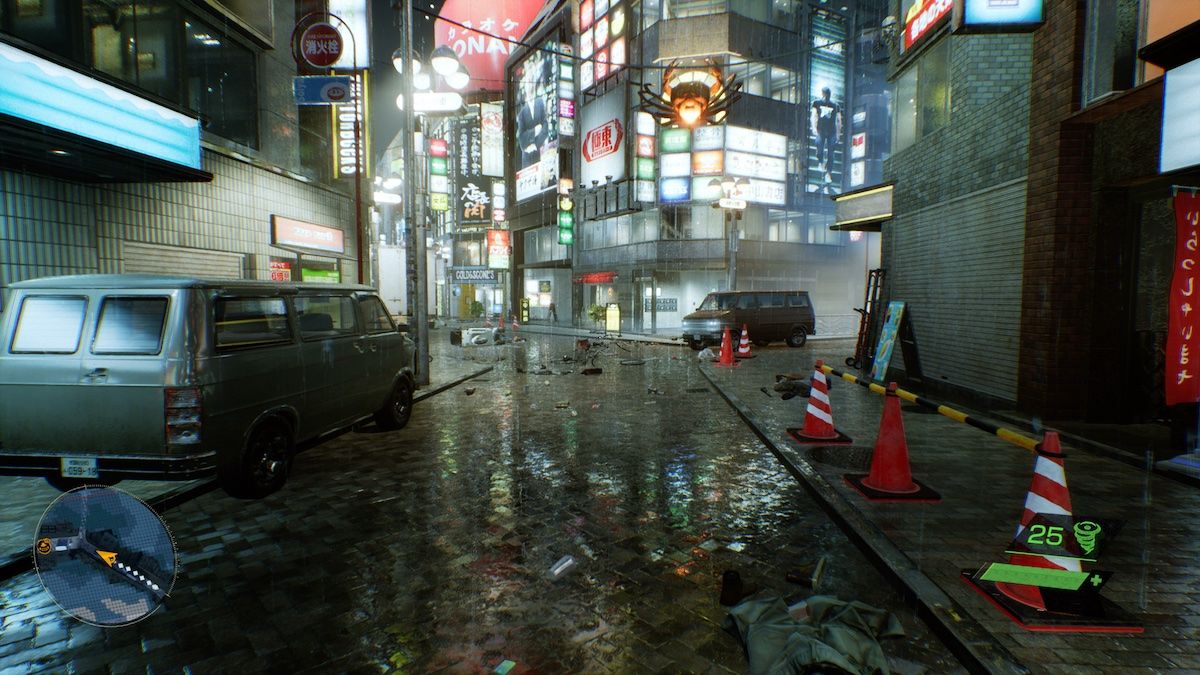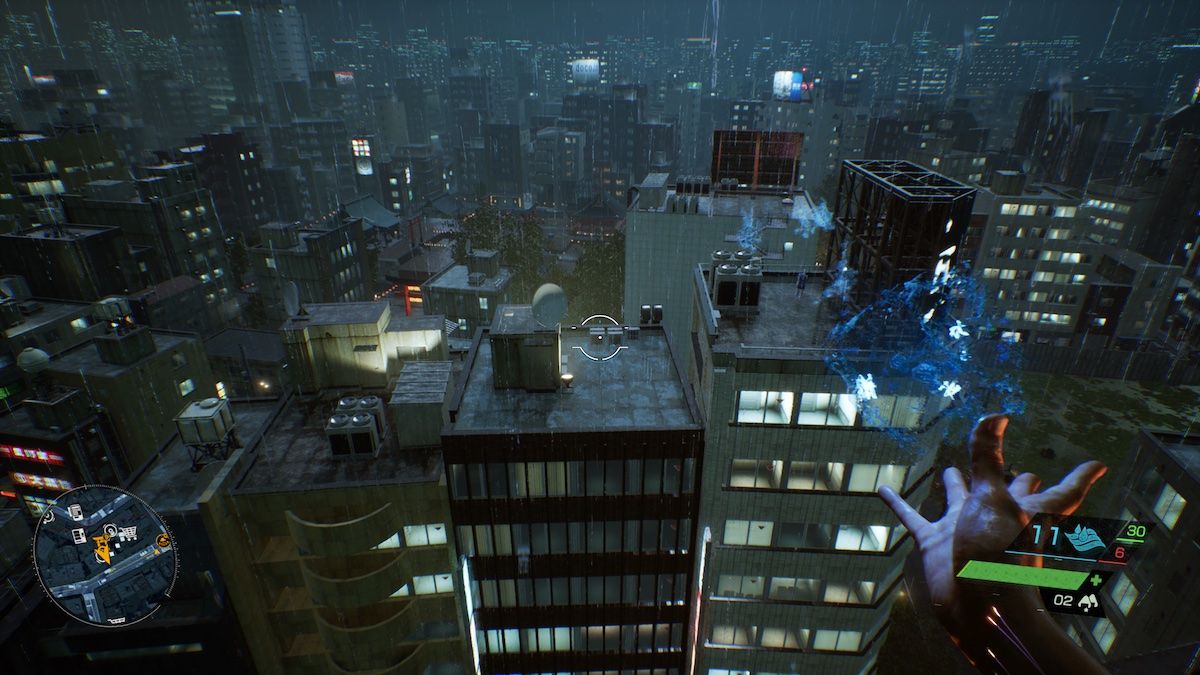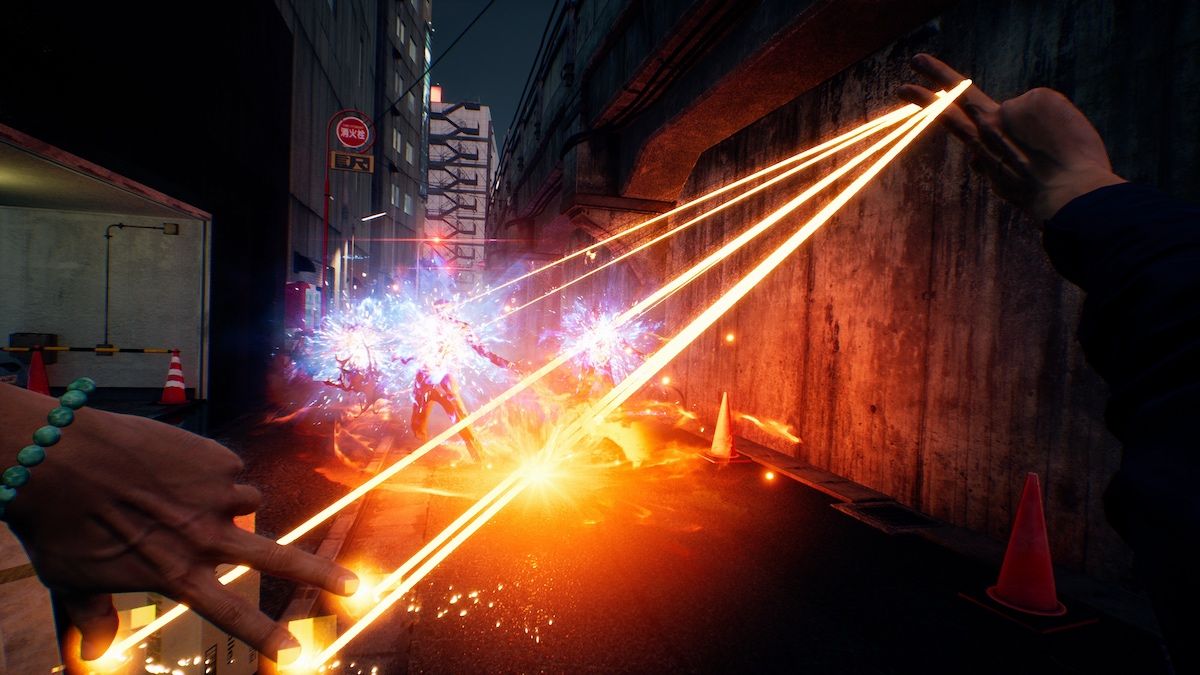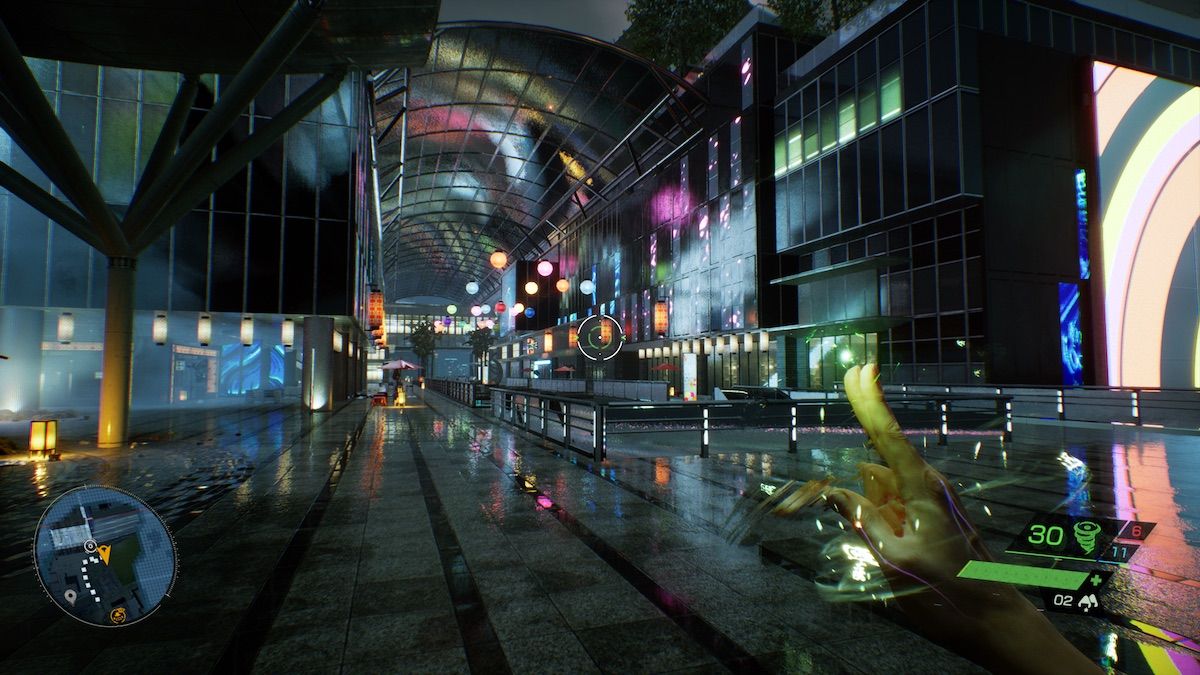It's understandable that both Bethesda and Tango Gameworks alike would want to distribute a fair and even split of focus towards as many of Ghostwire: Tokyo's early proceedings as possible, so the one driving thought I had coming out of the recent hands-off showing was as follows: "so...can I just go off and take in the sights?" The answer has turned out to be yes, but not in the way I originally imagined. While that curiosity was a direct result of the intended aesthetic and rendition the game is so clearly going for, what I didn't realize was that my appetite for exploration -- albeit an acknowledged restriction given the early-game period -- would be met not just through the silent, drizzly back-streets on ground, but up above on roof-tops and atop city blocks alike. So while I secretly was hoping for priorities to shift to something that could unknowingly scratch that world-exploration itch, it's surprising to note just how quickly Ghostwire: Tokyo has accomplished this. And through something as simple as the act of parkour from one roof-top to the next. A defining (though far from the only) aspect of one's time spent thus far with Ghostwire: Tokyo and one I will gladly say is driving me to keep at this game one chapter at a time.
Coming into this piece, it would only seem natural to draw a modest level of concern on just what one can even talk about given restrictions in place dictate only the game's first two chapters are open to discussion about. What can I offer in a "hands-on/first impressions" manner, that won't be better suited to a more conclusive review in the coming weeks? Call it an indirect consequence of the game granting you a reasonable set of supernatural abilities in the early periods, but perhaps the developer suspected things would go this way. In which case touche Tango; for a narrative revolving around saving a city -- alongside much more personal matters -- from the clutches of a paranormal vice of bodysnatching fog and corporeal entities, Ghostwire: Tokyo has so far been defined by two distinct but complimentary aspects: how much parkour and traversal one has gotten up to, but also -- for those eager to see this game running on PS5 -- how nice it all looks.
No sooner than the first chapter -- and funnily enough, the literal first street one has to trudge through to get to the first objective -- the bright, electronic billboards and signage, reflected back in rain puddles. Your gaze not just forward, not just upward, but straight back onto the ground. Yes, puddles are a convenient excuse to show off the capabilities of a game's reflections -- ray-tracing or no ray-tracing -- but if Tango wanted to draw one's eyes straight away, the argument is in favor of them managing just that. A city and more importantly a game's rendition of said city that manages to further this underlining aesthetic unease of artificial glow with supernatural haze. The steel, glass and concrete palette of blacks and greys contrasting with the static, multi-colored flurry of advertisement boards...itself sitting next to that persistent but lethal haze of light-blue. Thankfully, Ghostwire: Tokyo doesn't spend too long in its early parts merely naval-gazing at its newfound technical wizardy and here's where the aforementioned gameplay -- namely, an arguably-unhealthy amount of time rooftop-hopping -- comes into play.
Admittedly it's a part of the game Tango seem all too aware has potential and are in a way not so subtly pushing to have its players engage with. So while it might not be as organic in its discoverability as one may like, that doesn't mean the resulting distraction is any less enjoyable. Call it collectathon bias or those former child-like platformer appreciation kicking in again, but Ghostwire: Tokyo now has two modes by which it can entice players in getting from A to B. Even if the reward is in gathering up more of the ample number of stray spirits you deposit at one of many pay-phones for extra cash and XP. But it's because the city skyline is in a way its own standalone geometry and level design to work out why there's been so much of an early-game time-sink. The act of movement may not have the same impact or deliberate "umph!" of weight as a series like Dying Light has -- specifically in those precarious moments where you just reach somewhere -- but Ghostwire wants to make its parkour-like traversal feel like something that is attainable but still warily risky.
But it's because Tango appear to have dedicated sufficient time in the way roof-tops and entire city blocks are constructed why this part of the game manages to evolve from a mindless distraction to that of a more pleasant accompaniment. In a game whose "pleasantries" on the visual and general aesthetic side seem to be waiting around every corner of every street -- regardless of whether there are Visitors (the game's terminology for many an other-worldly foe) also lying in wait. How nearby railings or overhead ledges tempt players to give it a go or figure out some more preferable route -- that this weaves into tackling key objectives is one I admittedly wasn't aware up until I went through the opening couple of chapters a second time out of morbid curiosity. Lo and behold, a more troublesome foe you fight along the way -- you can skip a large chunk of this sequence if you're poking around the edges of the level design enough.
That the simple act of taking a detour away from the blatant, colorfully-decorated route can reward you like this, while not an original idea, is a welcome one nonetheless. All of which constructed through little more than a glide ability and a subtle persuasion that certain objects may in fact be climbable. It's maybe not Dishonored or even Deus Ex levels of "ah-ha" wonderment on the labyrinthine nature of verticality, but this is all still left to the player's own want and need for discovery. The reason why traversal above ground has almost eclipsed anything happening at ground level. Not because what Ghostwire offers on its city streets is any less intriguing. Indeed, just as I was drawn into the city's (as I dubbed it) "freeze-frame"-esque state in a hands-off manner, I'd be lying if I said I haven't found modest curiosity with Ghostwire's use of color, lighting and sound particularly to further that tone of suspension. An uneasy placement between normality and abnormality. Whether it's restaurant/bar music of various genres still playing as if nothing's happened, or entering another public space whose own suggestion of something not right is illustrated by an abundance of clothing littering the ground. Oh and there are countless faceless/headless enemies ready to surround you should you make a wrong move.
That last sentence isn't intended to be dismissive, or that the more combat-focused encounters of Ghostwire: Tokyo aren't relevant. Far from: combat is very much a key component here, even in the introduction. But as noted: to speak heavily on what one can has experienced thus far is to risk sullying perception too heavily. I'll reserve judgment on the appeal and longevity of Ghostwire's particular brand of first-person, projectile-focused style of play, but there's a nagging feeling that this could get quickly repetitive. Thankfully there are smaller details and mechanics -- some of which I'm not at liberty at elaborating on just yet -- that could keep players feeling incentivized to engage with what's on show. Namely killing foes via stealth and how that might affect one's chances when things do eventually go south.
And that's discounting some pleasant left-field turns Ghostwire conjures at times to shake things up. An instance that stripped me of all my supernatural abilities, requiring me to escape one of the more linear sequences -- an instance of the game more appropriately encouraging its players to properly engage with stealth just to survive. A scenario that, if the introductory prompt is anything to go by, suggests this will become a common occurrence. Can the game still catch me off-guard now that I'm prepared for it? Not least if the environment in question feels open enough in providing multiple routes through? We'll see, but regardless of all the questions one still has as to the longevity and variety that combat can harbor, it's comforting to find that that idea of vulnerability -- conveniently and selectively applied it might be -- is not lost and that Ghostwire: Tokyo may still throw up a conundrum or two. If nothing else, much like its level design, there has been that odd time of: "hang on, I can do that?" of which the game hadn't, cleverly, tutorialized. But we'll save those specifically emergent examples for another time.
So here we are, around a dozen-or-so hours into Tango Gameworks' latest and the hopes/expectations I had coming away from the first preview are for the most part justified and well met now the game is in my very hands. The fictional rendition of a Tokyo ward unquestionably the immediate stand-out element thus far, but one whose visual and gameplay intrigue is two-fold. One of casually strolling its vacant city-streets and admiring the technical feat Tango look to have crafted here. And the other one this unsuspected enjoyment in the very act of movement. I look forward to how things open up in more ways than one. Not least because some questions remain wholly unanswered -- that of its combat, its narrative and perhaps how far the game's use of the PS5 hardware can really go. But if nothing else, this is a promising start to one's time in Ghostwire: Tokyo. A fictional Tokyo full of sights, sounds and surprises alike. Now if you'll excuse me: I've got some city-wide, supernatural, roof-top parkour to get back to.

